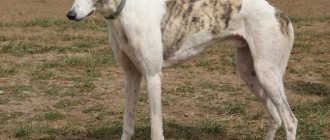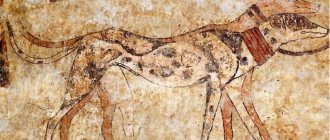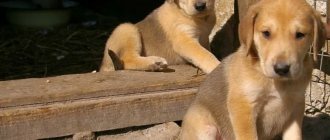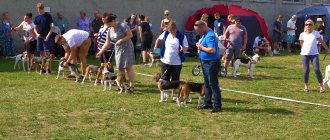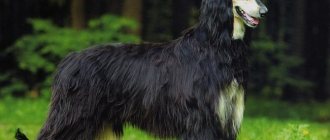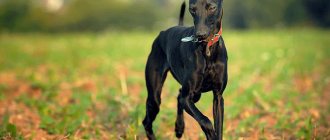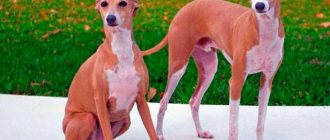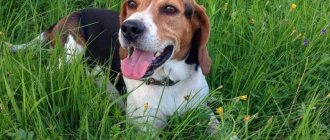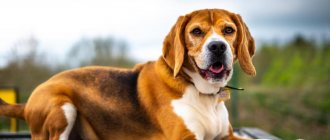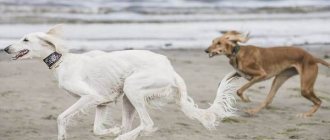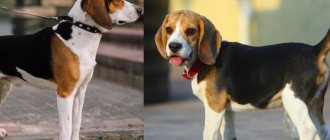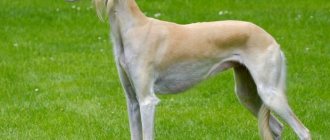| Origin: | Africa |
| Usage: | hunting, guarding, companion dog |
| Color: | red, sand, black |
| Dimensions: | height of males up to 70 centimeters, females - up to 65 centimeters |
| Lifespan: | 12-14 years old |
The Azawakh comes from Africa. Almost no selection was carried out on the breed. Its representatives are primitive dogs. Primitiveness means complete preservation of the original appearance. Included in the list of the rarest dog breeds.
Description
The Azawakh is a textbook on canine anatomy. They are that thin. The emaciated animal appears to be on the verge of death. This is a misconception. The Azawakh is a dog breed that is one of the hardiest in the world. Her thinness is defined by the standard.
Characteristics:
- The height of the animal reaches 70 centimeters. These are males, females are shorter - up to 65 centimeters. Weight should not exceed 25 kilograms. The weight range is large - from 13 to 25 kilograms. It is not surprising that with such height and weight, representatives of the breed seem emaciated.
- The head seems small. It is similar to a fox's muzzle, narrow and long.
- The ears are semi-dropping and widely spaced.
- The eyes are almond-shaped, brown in color. Small, closely planted.
- Large and black nose.
- The jaws are narrow and weak.
- The neck is long.
- The body is muscular and elongated.
- The dog's paws are very long and thin.
- The stomach is retracted.
- The tail is saber-shaped.
- The coat is short and the hair is fine. There is no fur on the belly.
- Acceptable colors are red, sand and black. African Azawakhs come in a variety of colors. There is no clear standard. It applies to European representatives of the breed.
Breed standard
The Azawakh dog is a medium-sized breed. The height at the withers of an adult reaches 70-73 cm. It weighs from 17 to 24 kg. A fat dog whose weight falls outside this range cannot take part in the exhibition.
The animal's chest is developed, muscular, slightly leaning forward during its movement. The neck is elongated and forms a slight angle with the body. The belly is sunken, the body is powerful. An arch forms on the lower back.
The paws of the African greyhound are very long, up to 50 cm in height. The hind ones are longer. They are resilient and very strong. The muscles on the thighs are well developed. The tail is thin, long, semi-curled. When the dog is excited, he straightens up.
The muzzle on the small head is elongated. The jaws are clenched tightly. The teeth are strong and sharp. The ears are triangular in shape and hang down. The tongue is long and pink. The eyes are almond-shaped and dark.
The Azawakh's coat is short and brown. According to the standard, it should be bright and shine in the sun. Most often, puppies of this breed are born with a white mark on the sternum.
Character
This breed has a complex character. Azawakhs are independent. He does not like affection and avoids touching. Perhaps the behavior is related to distant ancestors. Nobody caressed them. The human hand is a source of pain for them. The Berbers were distinguished by their cruelty; they easily used physical force against their pets.
Despite their independence, the Azawakh dog breed is devoted to its owner. The animal obeys only him. He is friendly with other family members, but remains neutral.
Doesn't like strangers. Extremely suspicious of them. An Azawakh won't bite, but it can knock you down. The fact is that in their homeland, the Azawakh dog breed served as an “alarm signal.” The animals spent the night on the roofs of houses. The Berber houses were low. The dog calmly climbed onto the roof and slept there.
When a predator or stranger approached, the Azawakh would bark loudly, notifying the owner of the danger. The uninvited four-legged guest had a hard time. The greyhounds tore him to pieces. The stranger walked away with fear. The African greyhound would knock you down, lie down next to you and guard you until the owner appeared.
Azawakh (FCI name) loves freedom. Racing under the hot sun in pursuit of prey is in his blood. In Russia there is no such sweltering heat as in the homeland of dogs. Sand is replaced by fields and forests. The animal will happily run through the fields. Play or hunt field mice, releasing pent-up energy.
Not suitable for apartment living. The Azawakh dog breed needs long runs. Providing them in the city is problematic.
Interesting facts about the Azawakh
The Azawakh is an ancient breed, about which a lot of interesting things can be told:
- The fleet-footed and tireless African hound is capable of chasing prey for more than 5 hours, moving at a speed of 60-65 km/h.
- Having overtaken the animal, the Azawakh does not kill it, but gnaws its tendons and holds it until the owner arrives. Thanks to this, the African greyhound is highly valued by the Tuaregs and is held in their special regard. The dog is surrounded with care and allowed into his tent.
- The absence of excess fat, thin light bones, flat belt-like muscles and short, sparse hair help the Azawakh to withstand the sweltering heat.
Socialization
The Azawakh does not like children. They make a lot of noise, which dogs cannot stand. The nature of the Azawakh is such that the animal does not tolerate intrusion into its personal space. Begins to actively defend itself against the troublemaker. Children, especially small ones, do not understand this. The dog makes them curious and tries to get to know each other. The child violates the dog’s space and receives a decisive rebuff.
Kids are restless and active. They can't sit still, they need to run. Running around will turn on the dog's hunting instinct. She will catch up with the child and knock him down. Therefore, it is better to refrain from buying a representative of the breed if there are very small children in the house.
The dog is loyal to his own kind. Since ancient times I have been accustomed to a large number of dogs in a pack. Azawakhs have a dominant character. Among their own kind, they will decide who is in charge here. Fights are possible between them and other dogs, until a hierarchy is established.
Cats for representatives of the breed are prey. An Azawakh can be made friends with a cat if the animals have been together since childhood. But the domestic cat is his own and cannot be touched. Street cats are strangers, objects of hunting.
Rodents and birds are on the same level as cats. Prey that must be caught.
Reviews
Konstantin:
The breed captivated us with its working qualities and unusual appearance. I am a hunter and greyhounds are my weakness. I waited a long time for my Jackie, I even had to go abroad to the nursery myself. I believe that buying one from dubious advertisements is an unjustified and expensive risk. My dog turned out to be a wonderful hunter, or rather a huntress. The training went off with a bang, but she only perceives me, and her wife and son don’t seem to exist for her. In general, I am very pleased with the long-awaited acquisition.
Anatoly:
I always take my Azawakh with me hunting and never return home without catch. If I come across newcomers, I always catch glances in the direction of the dog full of pity. They think that it was me, such a beast, who brought the dog to exhaustion, until they see it at work and find out about the breed.
Share your Azawakh stories with us. It would be interesting to know where you got the puppies, how they were trained, as well as the hunting achievements of your pets. Or perhaps they have become your favorite companions. Previous in category
How to choose a puppy
Azawakh puppies are nimble and active. A beginner is not always able to choose a good dog. There are recommendations for choosing a baby.
When buying a puppy, pay attention to its behavior. If the prospective pet behaves impudently, offends its sisters and brothers, and runs around the house like a hurricane, it is worth adopting. He will grow up to be an excellent dog, fearless and loyal.
Training
It is difficult to train this dog; outright coercion and harshness cannot be applied to it. In response to the aggression of the trainer, the Azawakh either shows aggression or withdraws into himself and further relationships with the person will be difficult. The main thing is discreet love, praise and food encouragement.
The dog is not for group exercises in a common area! She will not tolerate competition.
These dogs should have short, sonorous and sonorous nicknames - like any hunting dog: Grif, Jug, Boy - for a male. For a bitch - Gray, Berta, Zara, etc. In a good kennel, a puppy receives a name at birth that begins with the same letter.
Garde-Epee is considered one of the best Azawakh nurseries. This is a French line. In Russia you need to look for dogs of this breed. How to choose a puppy: you should look at your future pet no earlier than one and a half to two months. Not only the exterior, the condition of the coat and the musculoskeletal system are assessed, but also the character: human-orientedness is determined early. A cowardly or aggressive puppy is a breeding defect. The price of an Azawakh puppy starts from $350. French dogs can cost several times more.
Features of maintenance and care
The African Greyhound is content with the minimum. She does not require special care. The owner should know that the animal does not tolerate cold well. The Azawakh can withstand monstrous heat. But it will die from sub-zero temperatures, which other breeds can withstand without problems. Greyhounds from Africa need warm clothing. This will help her survive the cold season.
Combing
If you look at the photo, the Azawakh appears to be hairless. This is a deceptive impression; the representative of the breed has fur. It is so thin that it is enough to brush it once a week.
Bathing
The dog hates water. In rainy weather he prefers not to go outside. When he encounters a puddle, he will take the tenth route around it. Bathing a pet is torture. And there is no need to torture him more than once a year.
Walk
African Greyhounds need long walks. An Azawakh deprived of physical activity will find use for its energy. He will make a dig, leave the enclosure, and restore “order” in the garden.
Walk dogs at least five to six hours a day. If possible, let him walk around the garden all day. In winter, it is advisable to refrain from such walks.
Feeding
In Africa, the Azawakh eats what it catches. The owner feeds him with leftovers from his table. Nobody makes a special dog menu.
In Europe, the attitude towards dogs is different. Breeders feed them meat and vegetables. Beef or veal is the basis of the diet.
Other breeders prefer super-premium dry food with the addition of vitamin E.
Adult dogs are fed twice a day, puppies more often. Five to three times, depending on age.
Brief history of origin
The African Greyhound is an ancient dog whose exact origins cannot be traced. Experts suggest that the breed originated about 14-15 thousand years ago, as evidenced by rock paintings depicting similar animals.
The official homeland of the Azawakh is considered to be the area in northwest Africa, in the Niger River basin. These dogs accompanied nomads crossing the Southern Sahara and were used for guarding and hunting in open areas. The animals were subjected to strict selection, thanks to which they acquired their best qualities.
Long-legged, fine-boned dogs were highly valued by representatives of African tribes. For example, the Tuaregs would trade a purebred Arabian horse for one well-trained Azawakh.
For a long time, dogs were not exported outside the African continent. But in the 1970s they finally came to Europe. This happened thanks to the French ambassador Pecker.
The diplomat received a male Azawakh from an African tribe as a reward for saving him from a wild elephant. Later, the ambassador was given a female of the same breed.
The African Greyhound received official recognition in 1981. The breed standard appeared in 1993.
Health
Greyhounds from Africa are some of the healthiest dogs on the planet. What other breed can adapt to sweltering heat, lack of food and water in the required quantities and hunting under the hot sun.
Azawakhs have no genetic diseases. The only peculiarity of the breed is intolerance to cold. Starting from early autumn until late spring, the pet must be taken into the house. Take them out for walks in warm clothes.
Vaccinations
Standard complex. The first vaccinations are given by the breeder. Subsequent annual ones are the owner. The complex includes vaccination against rabies, distemper and infectious diseases.
Dog names
By the time you purchase a puppy, it will already have a name that is included in the metric, and is also pedigree and official. Whether you use this nickname in everyday life or give it another is up to you. The following nicknames may be suitable for the African hound:
- for males - Allen, Zidler, Gurkhan, Anzhey, Gringo, Dave, Lambert and others;
- for bitches - Zakira, Veggie, Michi, Jaina, Nike, Besta and so on.
As well as other names and nicknames that will be well perceived by the dog by ear, easy to remember and pronounce.
Mating
In the homeland of the Azawakh, the question of mating will seem funny. Nobody is watching this. If a bitch becomes pregnant during her first heat, her owner will not worry.
Breeders are stricter about matings. Males and females over the age of two years are allowed. Those who have received permission for breeding and have passed a veterinary examination. Mating will take place only if veterinarians do not find any abnormalities in the intended parents. This practically never happens; dogs are in good health.
Price
The cost of the dog is not too budget. Therefore, you definitely won’t be able to buy an Azawakh for pennies. Officially registered breeders are ready to offer prices from $500 and above.
Azawakh puppies
However, the price may be higher. It all depends on the gender of the puppy, its pedigree, the merits of the parents and class. In nurseries, the cost may be slightly lower than from breeders. However, factors such as age and pedigree also play a role here.
Proper nutrition
The Greyhound breed does not have any dietary peculiarities. They easily eat the same food as other breeds.
The only difference in the diet is that the products should contain a lot of calcium, since animals have a fairly developed skeleton that needs regular reinforcement.
Don't forget to give your pet big bones so that he remembers his hunting skills.
